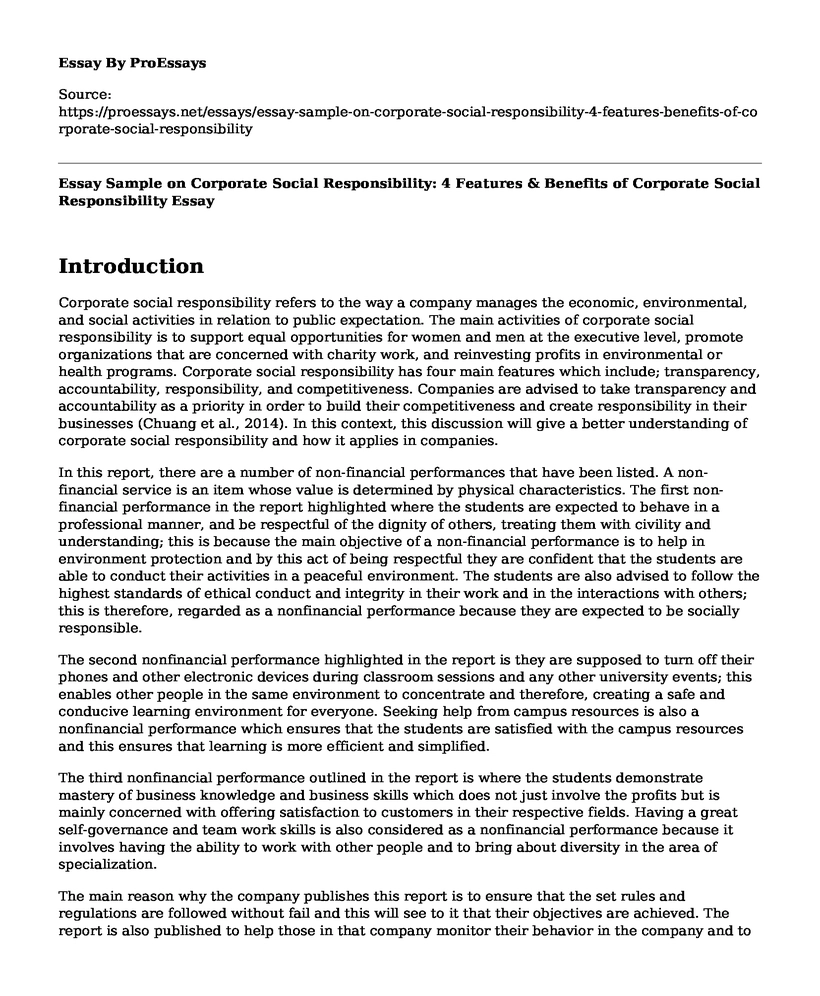Introduction
Corporate social responsibility refers to the way a company manages the economic, environmental, and social activities in relation to public expectation. The main activities of corporate social responsibility is to support equal opportunities for women and men at the executive level, promote organizations that are concerned with charity work, and reinvesting profits in environmental or health programs. Corporate social responsibility has four main features which include; transparency, accountability, responsibility, and competitiveness. Companies are advised to take transparency and accountability as a priority in order to build their competitiveness and create responsibility in their businesses (Chuang et al., 2014). In this context, this discussion will give a better understanding of corporate social responsibility and how it applies in companies.
In this report, there are a number of non-financial performances that have been listed. A non-financial service is an item whose value is determined by physical characteristics. The first non-financial performance in the report highlighted where the students are expected to behave in a professional manner, and be respectful of the dignity of others, treating them with civility and understanding; this is because the main objective of a non-financial performance is to help in environment protection and by this act of being respectful they are confident that the students are able to conduct their activities in a peaceful environment. The students are also advised to follow the highest standards of ethical conduct and integrity in their work and in the interactions with others; this is therefore, regarded as a nonfinancial performance because they are expected to be socially responsible.
The second nonfinancial performance highlighted in the report is they are supposed to turn off their phones and other electronic devices during classroom sessions and any other university events; this enables other people in the same environment to concentrate and therefore, creating a safe and conducive learning environment for everyone. Seeking help from campus resources is also a nonfinancial performance which ensures that the students are satisfied with the campus resources and this ensures that learning is more efficient and simplified.
The third nonfinancial performance outlined in the report is where the students demonstrate mastery of business knowledge and business skills which does not just involve the profits but is mainly concerned with offering satisfaction to customers in their respective fields. Having a great self-governance and team work skills is also considered as a nonfinancial performance because it involves having the ability to work with other people and to bring about diversity in the area of specialization.
The main reason why the company publishes this report is to ensure that the set rules and regulations are followed without fail and this will see to it that their objectives are achieved. The report is also published to help those in that company monitor their behavior in the company and to ensure that they perform their duties according to the company needs. In this company, the corporate social responsibility expects everyone to be self-disciplined and self-driven in achieving their goals and it also emphasizes on the need to be professional in the activities that they undertake in order for them to accomplish their desired goals.
Conclusion
In conclusion, corporate social responsibility helps in creating a social network that is important in the business sector and this helps in creating a bigger market for the company and it also helps in building a stronger social network. This social network helps in creating a loyal customer service which people can trust. Corporate social responsibility also creates an environment that is conducive for everyone and therefore, making it possible for people to carry out their activities efficiently.
References
Branco, M. C., & Rodrigues, L. L. (2006). Corporate social responsibility and resource-based perspectives. Journal of business Ethics, 69(2), 111-132. Retrieved from https://link.springer.com/article/10.1007/s10551-006-9071-z
Frigo, M. L. (2002). Nonfinancial performance measures and strategy execution. Strategic Finance, 84(2), 6. Retrieved from http://search.proquest.com/openview/97243f07fe981e1c7e699253617ecb36/1?pq-origsite=gscholar&cbl=48426
Tai, F. M., & Chuang, S. H. (2014). Corporate social responsibility. I business, 6(03), 117. Retrieved from https://www.scirp.org/html/3-8601351_49900.htm
Cite this page
Essay Sample on Corporate Social Responsibility: 4 Features & Benefits of Corporate Social Responsibility. (2023, Apr 23). Retrieved from https://proessays.net/essays/essay-sample-on-corporate-social-responsibility-4-features-benefits-of-corporate-social-responsibility
If you are the original author of this essay and no longer wish to have it published on the ProEssays website, please click below to request its removal:
- Article Analysis Essay on Meet the Life Hackers by Clive Thompson
- Essay Sample on Six Months as Firefighter: Notes on Labour and Trends
- Essay Sample on Internal Conflict: Responding to Knowledge, Beliefs, and Opinions
- Essay Example on Apple's Leadership Edge: How Steve Jobs Transformed Performance
- Truth-telling: Building an Encouraging Working Environment - Essay Sample
- Essay Example on Mediation: Disclosing Conflict of Interests for Fair Resolution
- Essay on Healthcare KPI: Evaluating Quality Care & Enhancing Hospital Performance







